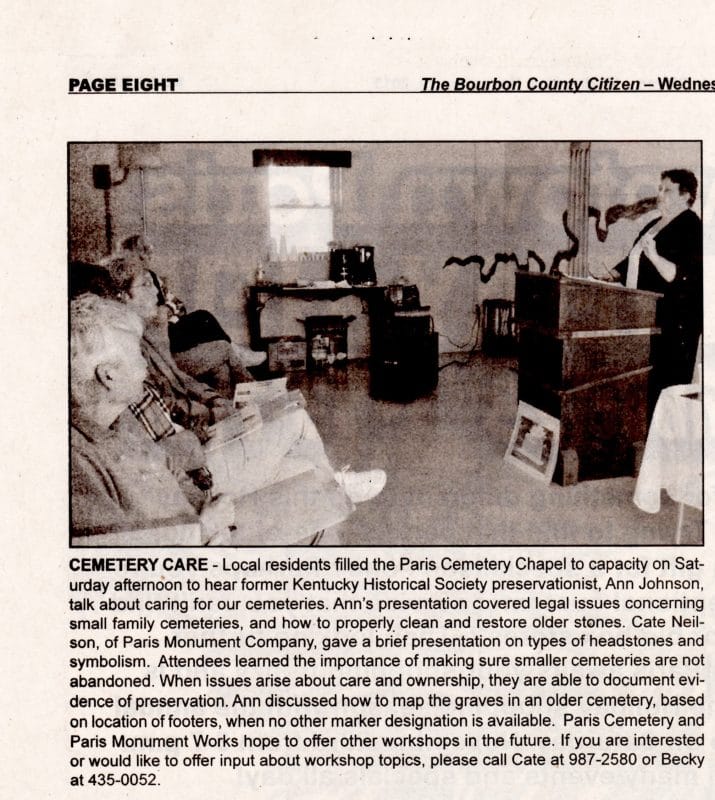Stories In Stone
Stories in Stone – By Cate Neilson for The Citizen
The business of making cemetery monuments has a long history in the city of Paris. One hard-not-to-notice reminder of this enterprise is the massive granite building next door to the cemetery gates. People say ‘it’s always been there,’ which is not exactly true.
In the early 1930s, Fred Hilke relocated from Lexington to Paris as a junior partner with the monument company then located here, but it was another decade before he became the owner of that company and began construction of the present building on S. Main. The working of granite and marble for tombstones, however, had been in Paris long before the arrival of Hilke or his building.
Perhaps the earliest ‘company’ in the monument trade was Bourbon Marble and Granite, owned by W. A. Hill, Sr. from the mid 1850s until 1908. Hill’s company, also located on S. Main but in the 600 block, was profiled in 1905 in History of Paris and Bourbon County. Hill shipped Vermont marble and granite by train to mark the graves in Paris cemetery of such people of note as John W. Harmon, Col. John G. Craddock, and America Butler.
After Hill’s death in 1908, it’s possible the company was sold to Adams & Wallen, who, with the intent of building a monument-making facility, purchased land in June of that year from the railroad, and in October opened directly across from Paris cemetery. That building was 22 x 60 feet, with shed in the rear and a lifting jack for the landing and unloading of stones. Ross Adams was the son of W.A. Adams, who had a monument building in Lexington at the time. For some reason, in 1910 Adams bought out Wallen, but then in 1911 sold the lease on the land where the business was located to someone else.
Also in 1911, W.A. Wallen, who had moved to Paris in 1908 with the specific purpose of operating such an endeavor here, joined into partnership with a Maysville monument company, and the three partners opened a branch in Paris under the name of Murray & Thomas Co. It appears they must have found a way to lease or buy the location on S. Main, since that is given as their address.
After Wallen’s sudden death in 1917, Murray and Thomas continued operation of the company until 1922. That year, they decided to dissolve their corporation, with Murray taking the assets in Maysfield and Thomas taking those in Paris. W. Fred Thomas managed the Paris facility for another 13 years.
But in the early 1930s, Thomas brought on a young man named Fred Hilke. Hilke, whose father had died when he was thirteen, forcing him to seek employment, had apprenticed with a monument maker in another part of the state and had been trained in cutting stone. He and his family moved around quite a lot in the early years, but finally he wound up working for a monument company in Lexington. From time to time Mr. Thomas would call upon him to engrave dates of death on markers in Paris and the vicinity. Jim Hilke, Fred’s son, remembers his father telling him how at that time they hooked their machinery into a spark plug, and used the car as a generator to do the work. This collaboration eventually led Thomas to bring Hilke on as a junior partner.
When Mr. Thomas died in 1935, Fred Hilke purchased the company from his widow, and renamed it Paris Monument Works. Hilke’s family owned the company until 1977; Fred designed and built the current granite facility in 1941, using bricks and equipment from the previous location across from the cemetery, as well as from the Southside School, which was located on the property purchased for the new building on the corner of Main and 16th. Jim Hilke talks about helping his father scrape cement from the bricks to prepare them for use in the new building. His father also designed the monument in front of the building, which shows the history of creating headstones.
Although times were hard after the depression and with the beginning of WWII, Hilke kept a large operation going at his S. Main location. Granite was picked up from the train upon its arrival and brought to the back of the building, where it was polished and shaped, then engraved by the stonecutters. Evidence of work and equipment areas can still be seen in there, alongside inventory belonging to the current owners.
Jim Hilke, after serving in the military then working out of state, returned to Paris in the 1960s to help his dad run the business. After his father’s death, he continued to operate the company with his sister and brother-in-law, Evelyn and Bill Nolan until 1977, when he sold the company to another monument company in Lexington. Although he stayed on to help with some training, much of the equipment was sold, and the facility ceased to be the actual location where the monuments were made.
After several changes in ownership, Paris Monument Works is currently a satellite facility for NAHSI. Ironically, the Keith family has its own monument-making history in Kentucky, dating back to the 1860s. Although production is handled at the company headquarters in Elizabethtown, and some through the Rock of Ages company in Vermont, remnants of a forgotten era are still visible at 1601 S. Main. The chains and pulleys that once hoisted and moved heavy granite blocks from one production area to another, where they waited to be carved and engraved by local artisans, speaks of a simpler time, when life and work stayed close to home. And the imposing granite building, itself a monument to days gone by, is a fitting tribute to those who came before, to help us in a final honoring of those we loved.

